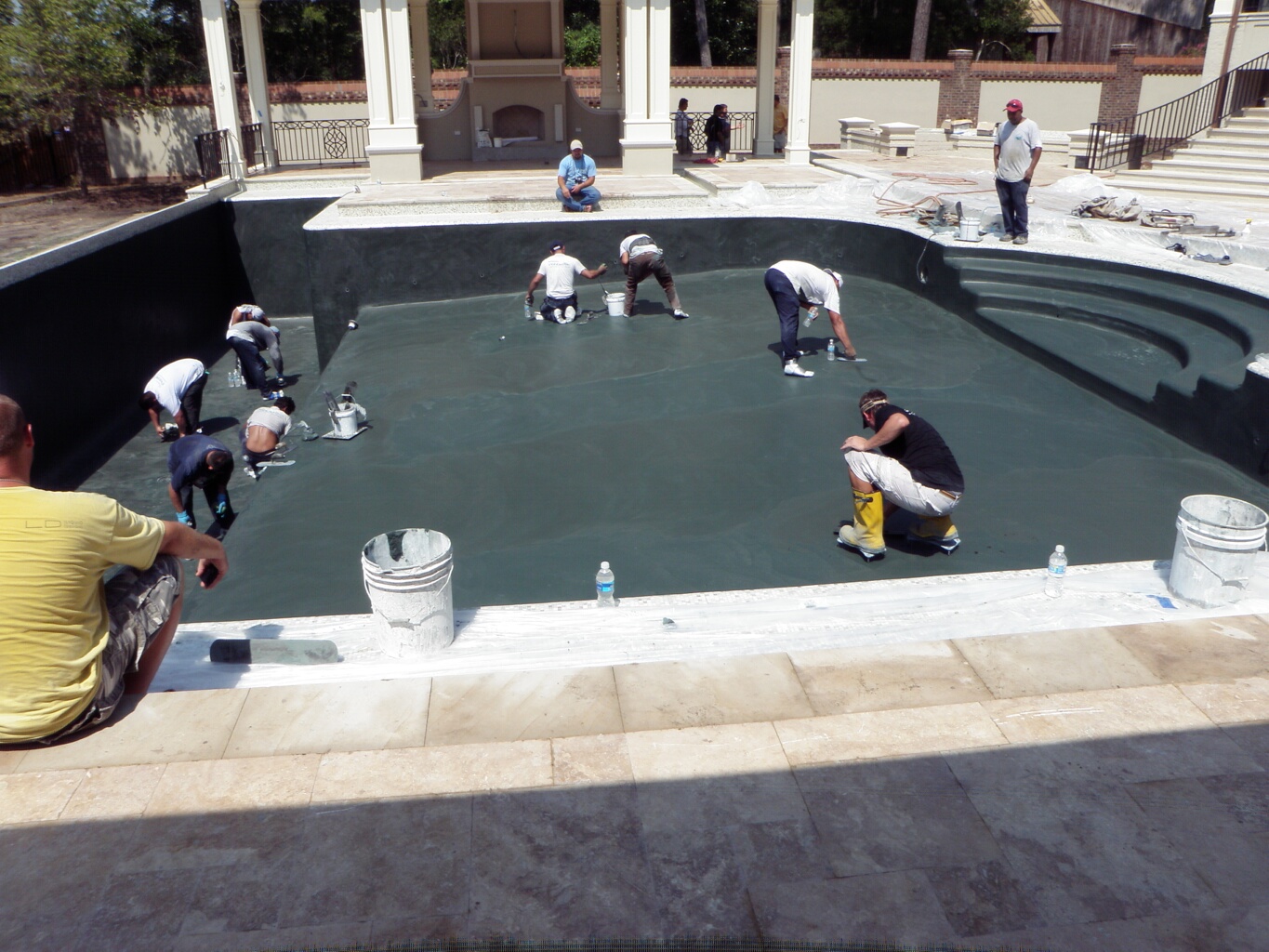Unconventional Plaster?

 When I started my career more than 20 years ago, habit and standards dictated that swimming pool plaster should be white. By that time, happily, a handful of suppliers had begun offering colored aggregates, and then products including PebbleTec began expanding the palette to a point where about a dozen colors were available, give or take a few. These were shades of blue, mostly, ranging through to grays and darker grays.
When I started my career more than 20 years ago, habit and standards dictated that swimming pool plaster should be white. By that time, happily, a handful of suppliers had begun offering colored aggregates, and then products including PebbleTec began expanding the palette to a point where about a dozen colors were available, give or take a few. These were shades of blue, mostly, ranging through to grays and darker grays.
Then, about ten years ago, watershape designer/builder David Tisherman very publically broke with anyone’s sense of convention by broadening his pool-plaster palette to include a rainbow of colors. His notorious Red Pool of 2002 was a real shock to the system – and he didn’t stop there, using greens and yellows and lavenders to distinguish his projects from just about anything else that was being done.
Tisherman ripped Pandora’s Box wide open, but convention still rules to this day – and it’s my contention that this is so because watershapers don’t know the hows or whys of plastering in color. Artistic Resources & Training (ART), in conjunction with Pebble Technology (Scottsdale, Ariz.), will soon crack that barrier with a class on working creatively and effectively with custom plaster colors.
Just imagine a design professional greeting a new client with an entire spectrum of finish-color possibilities. Imagine learning how pool plaster as well as concrete and stucco can be custom-colored to suit a client’s and a setting’s specific requirements. Imagine how powerful a tool all the colors of the rainbow are when stacked up against a sample board displaying a dozen conventional blue/gray colors.
Breaking Out
When I was a student, I was constantly asked to think about what I was doing and how I was doing it, but only seldom was I challenged in the classroom to think about how things might be done better.
Educational programs are, in that respect, most in their comfort zone when they encourage us to think along conventional lines. True, pushing toward unique solutions was often rewarded with good grades and might win the admiration of the instructor, but it generally wasn’t expected. As a result, blazing a trail through the system became much more difficult.
I’ve thought a lot recently about the way my education flowed and about how much more I might have learned if my professors had more frequently indulged the inclination to foster creativity and innovation. With that in mind, I have taken matters into my own hands and am working – in collaboration with other members of the ART faculty – toward developing the kind of dream courses I wish I’d been able to take while I was in school.
I do so for one reason: If the art of watershaping is to advance in the way it must to meet the desires of today’s consumers, we need to free ourselves from the burden of conventional thinking and, in some cases, completely rebuild our approaches. This upcoming class on the coloring of cementitious materials is a big step in that direction.
Way Beyond Convention
By now, there are lots of watershapers out there who know more than they ever thought they would about color, how colors work together and technical issues such as hue, intensity, chroma and values. With further education, those who have a background in color theory can unshackle their creativity and learn how to design the color of pools in the same way architects determine colors for cementitious interior and exterior surfaces.
Yes, some background in color theory and materials is essential, but after a quick review the course will quickly move on to help students bring color to their projects more effectively. This involves building an understanding of the oxides, pozzolans and cement types (conventionally seen as the exclusive realm of plaster suppliers) that are like the pigments artists use to fill their canvasses with color. As part of the process, students will work with plaster’s base components, confronting mounds of raw materials and, with their own hands, blending them and seeing the results with their own eyes.
As I see it, this unique exercise in gaining control of the tools and materials of our trade is fundamental to raising what we do as watershapers to the level of art. To advance, we must be able to start with a fresh canvas and conceptualize what is the most appropriate color for any given situation. To advance, we must move beyond selecting plaster from suppliers’ sample boards and work with basic materials and all possible colors on our own terms.
David Tisherman would never sit still for Henry Ford’s edict that you could buy a car in any color as long as it was black. For too long, convention has restricted what we can do with our designs, and I think it’s high time to reclaim our ability as artists to work with what is right rather than what is available.
Moving forward, this is what I want ART to be about on all levels. It doesn’t mean convention is dead; it just means that we want and need the freedom to move beyond its baselines to deliver more to our clients than today’s sample boards allow.
Mark Holden is a landscape architect, pool/landscape contractor and teacher who owns and operates Holdenwater, a design/build/consulting firm based in Fullerton, Calif., and is head of Artistic Resources & Training (ART), an educational service for watershape designers. He may be reached at [email protected] more information on ART and its course catalog, click here.









